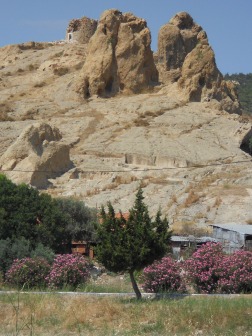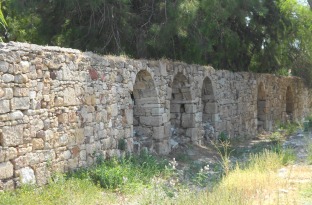Seal country Population: 27,000
Market day: Tuesday
Old names: Phocaea (Ionian Greek), Foglia Vecchia (Genoese)
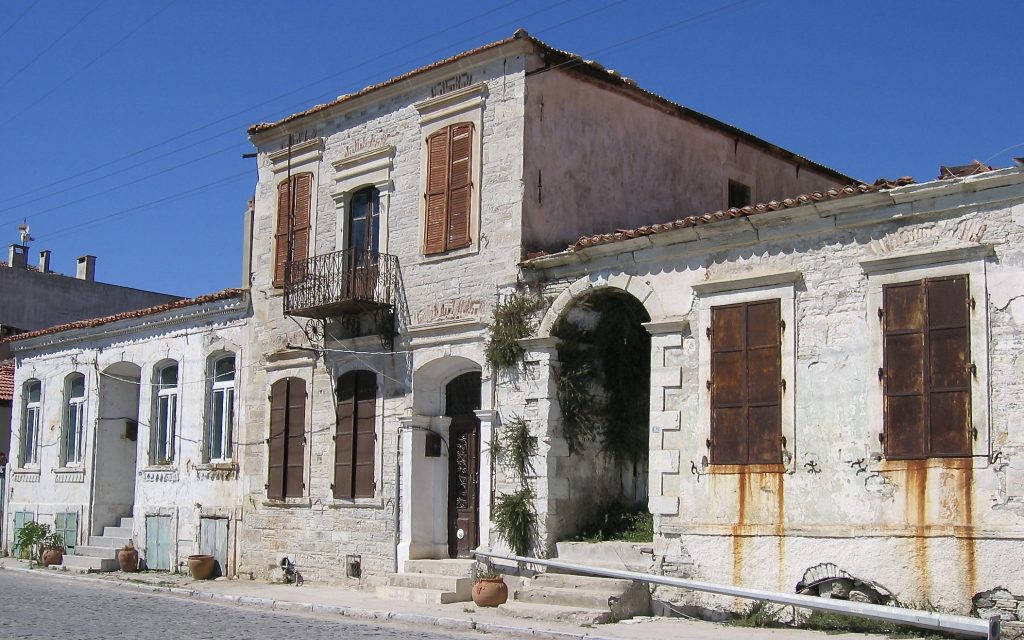 Just north of İzmir sit two small resorts, both called Foça after the ancient settlement of Phocaea that was a member of the Panionian League. The bigger of the two is Foça itself, sometimes called Eski (Old) Foça to distinguish it from its smaller neighbour, Yeni (New) Foça. Together, they make a great escape from the urban stresses of İzmir, which means that they both get very busy over weekends.
Just north of İzmir sit two small resorts, both called Foça after the ancient settlement of Phocaea that was a member of the Panionian League. The bigger of the two is Foça itself, sometimes called Eski (Old) Foça to distinguish it from its smaller neighbour, Yeni (New) Foça. Together, they make a great escape from the urban stresses of İzmir, which means that they both get very busy over weekends.
The sea around Foça is still home to a handful of rare Mediterranean monk seals (Monachus monachus), so named because the grey colouring of their backs set against the brown of the rest of their body resembles a traditional monk’s cowl. Since the Turkish for “seal” is “fok,” the town is often said to have been named in homage to the seals. However, other authorities think it more likely that Phocaea was named after the low-lying offshore islands which mariners may have thought resembled seals — called “phoce” in Greek.
Regardless, the monk seal is now a critically endangered species of marine mammal and there are probably a million tacky souvenirs making play with their image for every one of the remaining animals.
Eski Foça consists of two harbours separated by a headland. The larger harbour – the Büyük Deniz (Large Sea) – is still home to some serious fishing trawlers as well as to the ferries that connect the town to the Karaburun Peninsula in high season. The smaller harbour – the Kücük Deniz (Little Sea) – is home to much smaller fishing boats and is the more obvious centre for tourists.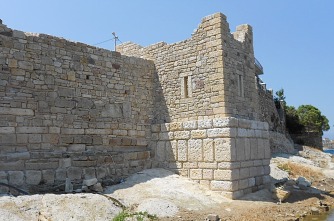 Newly restored wall on headland
Newly restored wall on headland
The Foças are mainly places to come to soak up the atmosphere, stroll along the seafront and eat good seafood rather than sightsee although Eski Foça does have a few specific attractions. The street on one side of the Küçük Deniz has been widened by means of a boardwalk from which people can swim in summer.
Don’t leave town without:
- tasting a mastic ice cream from Meşhur Girit Sakız Dondurmaları on the waterfront
Backstory
Phocaea is thought to have been founded in the eighth century B.C. by mariners from Erythrae on the Çeşme peninsula or from Teos, near Sığacik. It went on to become an important trading centre.
Determinedly independent, Phocaea fought hard to avoid submission to the Romans. In the Middle Ages it developed a new role as the site of a Byzantine bishopric, before being gifted to Genoese traders. By the time the Ottomans came riding into town in 1455 its glory days were well and truly behind it.
Around town
Of old Phocaea, disappointingly little has survived despite the fact that in its heyday it was an important town that sent colonists to found what is now Marseille in France.
Ancient Phocaea occupied what is now the site of Eski Foça, and it’s there that visitors can inspect the remains of a shrine to the Mother Goddess Cybele gazing rather romantically out to sea from the rocks around the base of the headland. This has been excavated to uncover what looks like a mainly medieval wall which has been reconstructed.
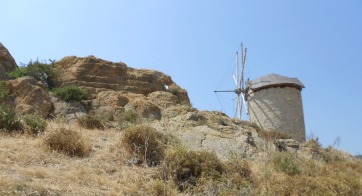 Otherwise the only other sign of old Phocaea in the centre is the long stretch of aqueduct that runs from beside the bus terminal right to the edge of town. The ground has risen over the centuries to bury the lower part of the arches so it is not as conspicuous as you might expect.
Otherwise the only other sign of old Phocaea in the centre is the long stretch of aqueduct that runs from beside the bus terminal right to the edge of town. The ground has risen over the centuries to bury the lower part of the arches so it is not as conspicuous as you might expect.
Heading out towards İzmir there are very slight remains of a theatre dating back to the fourth century B.C at the bottom of the hill topped by the windmills. The rocky landscape on view from the hilltop is actually more interesting than the theatre – but beware unchained dogs.
Some fine Roman mosaics were also unearthed in the town centre, giving a hint of what must have been. Today you can only see the foundations of what look like shops and houses on the top of the headland near the Fatih Cami. In lieu of a local museum odd bits of Roman stone are gathered together in a couple of places about town, including beside the fire “station”.
The Beşkapılar (Five-Gated) Castle which stands between the two harbours dates back to 1538-9 when it was built by Silahtar İskender Ağa, who supplied wood to Mustafa, the son of Sultan Süleyman the Magnificent. It may stand on the site of an earlier Genoese model. It is not always open to the public, which seems a shame when Foça lacks much in the way of organised attractions. However, once the rest of the adjoining walls have been restored this might change.
Above the castle stands Fatih Cami, paid for by the same Prince Mustafa in 1530-31, and virtually rebuilt in 1890, having suffered serious earthquake damage in the interim.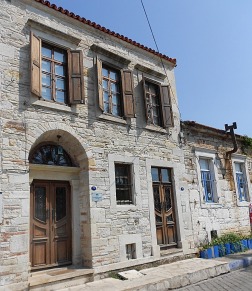
Under the Ottomans, both Foças had large and wealthy Greek populations. As you stroll along the waterfront promenade in Eski Foça you will be able to admire some of their fine stone mansions, some of them converted into pleasing hotels.
Eski Foça has no beach of its own although there are a number of small bays strung out along the road that links it to Yeni Foça. In the summer you can take daily boat tours out to the offshore islands and better bathing possibilities.
Out of town on a hill 2km to the southwest there is an ancient rock-cut tomb known as Şeytan Hamamı (Devil’s Bath). Eight km east of town and closer to the road the so-called Taş Kule/Taş Ev is a six-meter-high structure dating back to the 6th or 5th-century BC. It, too, was a tomb and shows signs of Persian (or Phrygian) influence. I have not seen either of them.
Eating
There’s a lively dining scene especially on weekends when İzmirlis pour in and tables at the popular Kordon and Celep harbourside restaurants are in short supply.
Sleeping
There’s accommodation to suit all budgets including many small pensions that accommodate the families of soldiers doing their military service at the nearby base when they come to visit. In high summer everything comes under considerable strain. It’s unwise to rock up without a reservation, especially at weekends.
Bulbul Yuvası. Tel: 0232-812 5152
Hotel Club Phokaia. Tel: 0232-812 8080
Hotel Villa Dedem. Tel: 0232-812 2838
Lola 38 Hotel. Tel: 0232-812 3809
Travel info
There are regular buses from the upstairs section of İzmir otogar to Foça. Less frequent timetabled buses connect it to Yeni Foça.
If you’re staying in İzmir you can also get to Eski Foça by taking the İzban to Hatundere station and picking up a bus.
To get to Bergama from Eski Foça, return to the main İzmir highway and catch an onward connection from Menemen.
In high summer there are ferries to Mordoğan and Karaburun on the Karaburun (Çeşme) Peninsula.
Day trip destinations
